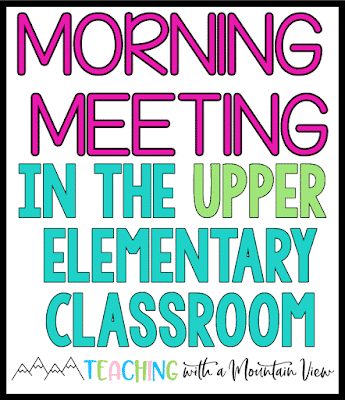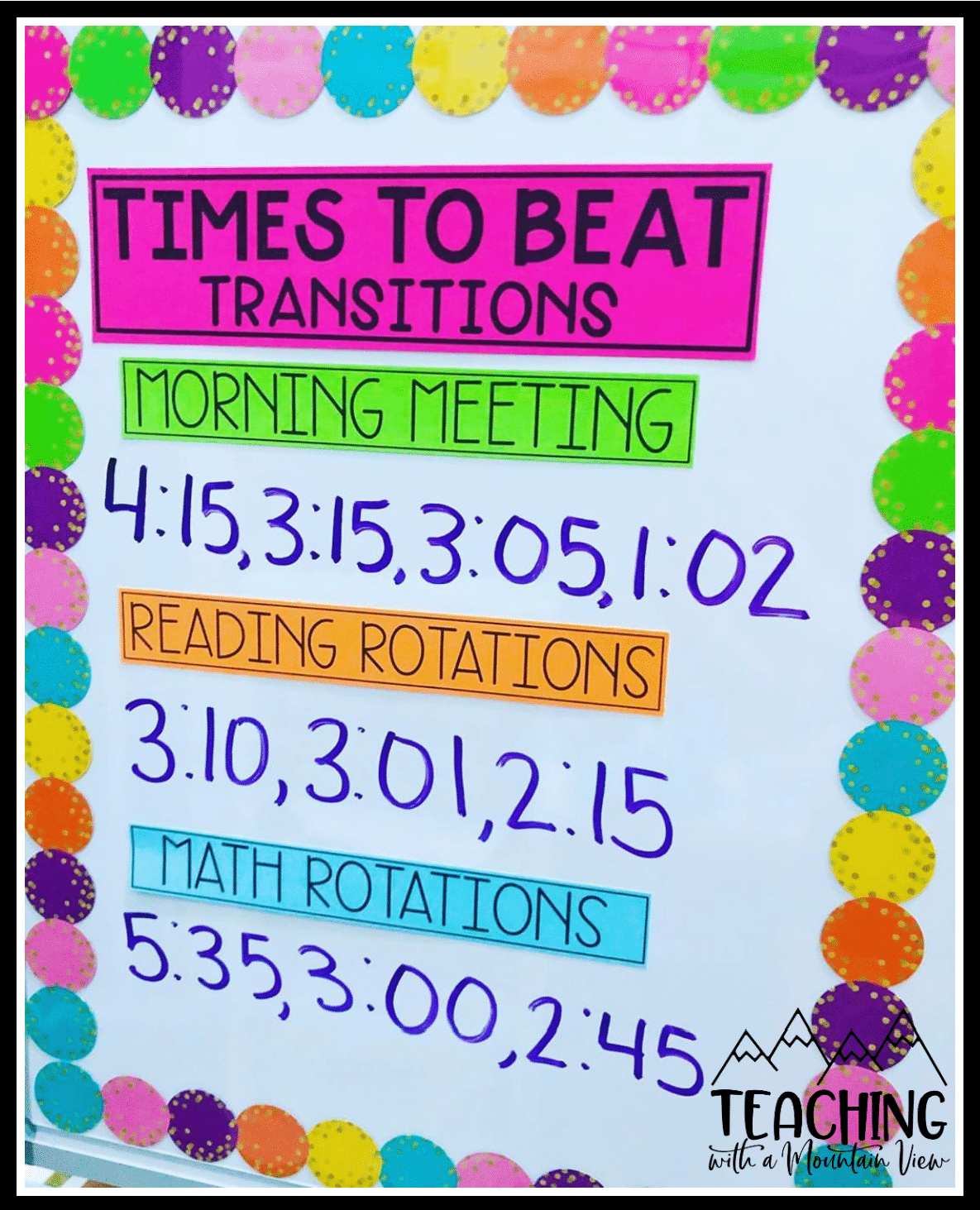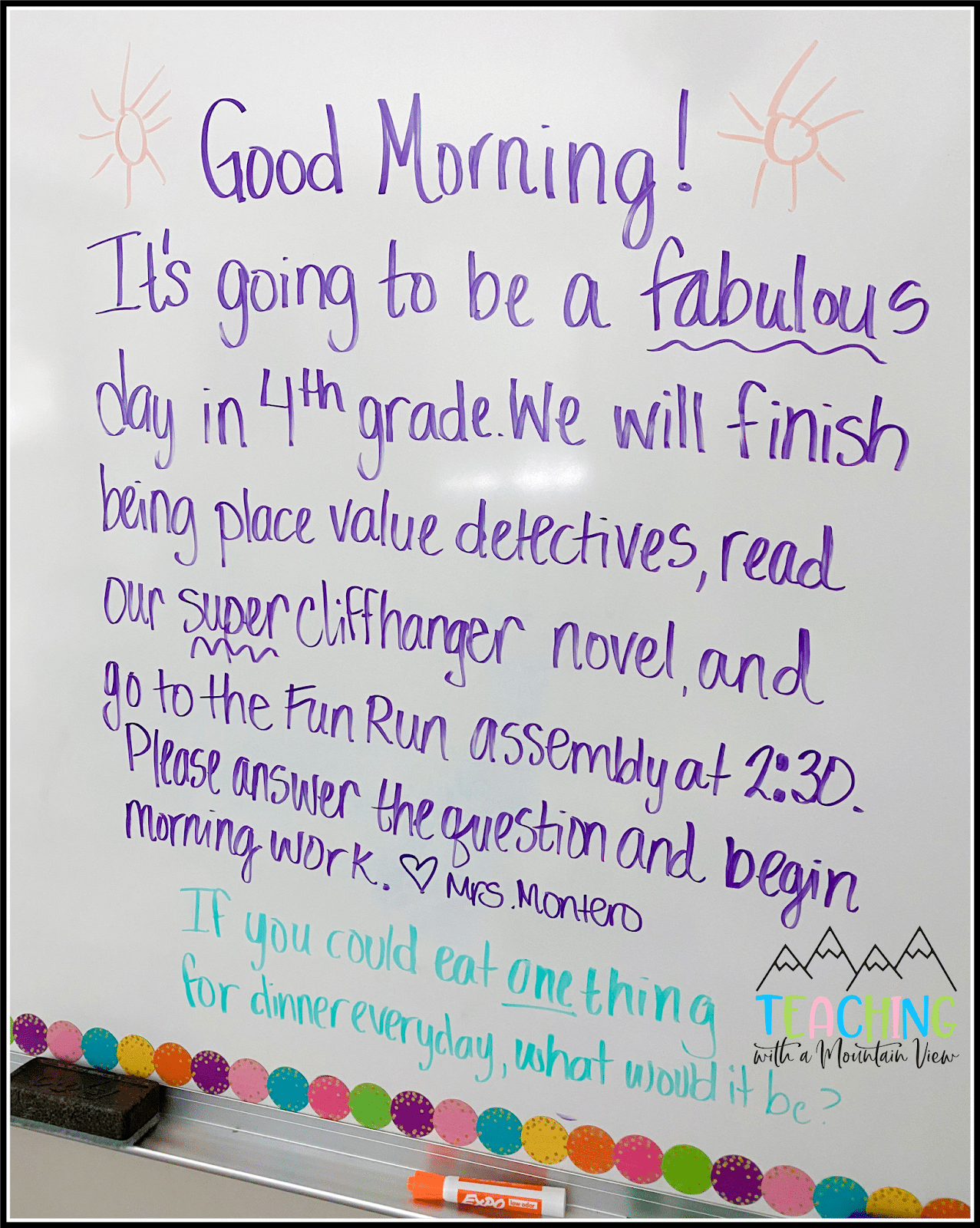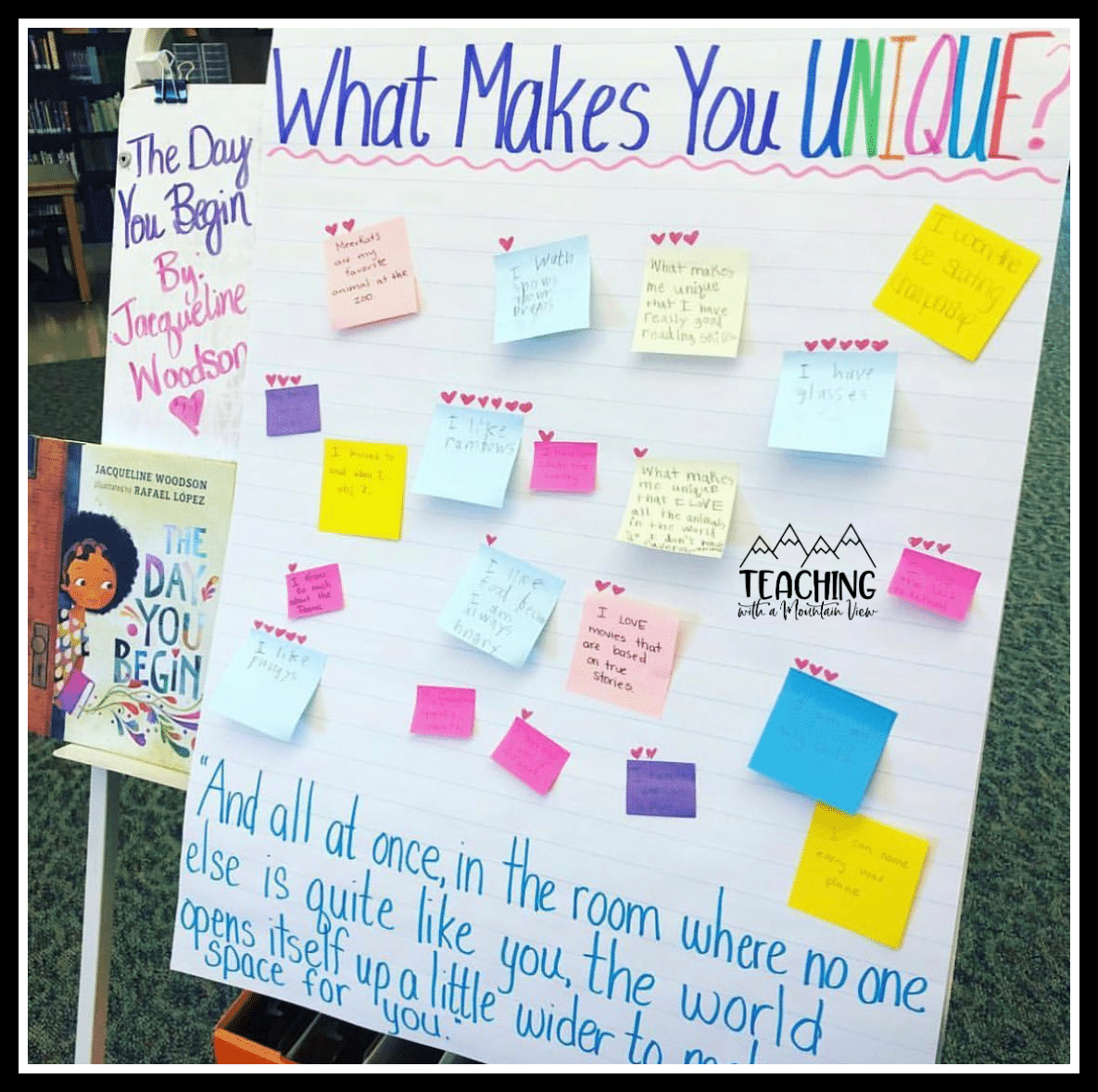Making Morning Meeting Work in your Upper Grades Classroom
By Mary Montero
Share This Post:

Morning Meeting. It isn’t just for the primary kids! I was lucky enough to get my very first job at a school that very much believed in the power of Morning Meeting. We were given the Morning Meeting Book from Responsive Classroom (which I HIGHLY recommend) and then were given autonomy to run our Morning Meetings in the way that best fit our classroom. To start, I followed the prescribed routines EXACTLY. Eventually, I was able to meld my Morning Meeting time into a precious tradition that fit my and my students’ needs.
Please Note: This post was written pre-COVID
So some adaptations will definitely need to be made to ensure social distancing. However, I still believe in the immense value of morning meeting, and I’d encourage it to happen as often as possible, even if it’s over ZOOM!
The Purpose of Morning Meeting
The foundation of learning is a trusting relationship with a caring and effective teacher, and the best learning environment is one that is emotionally safe for every student. Morning meeting goes a long way in achieving this goal.
When you start the day with a routine Morning Meeting, students can feel welcomed, relaxed, confident, and ready to learn. By spending time interacting with their diverse group of peers, truly listening to others and learning about others’ lives and perspectives, students’ ability to live together in the community and in society is strengthened every day.
The Basics of Morning Meeting
Morning Meeting is a 20-30 minute block of time reserved for team building in the classroom. This is not often academic in and of itself, but research suggests that its benefits can have an effect on academic performance throughout the school day. When completed as suggested, has four distinct parts that are supposed to be completed each day. Due to time constraints, grade levels, or other limitations, one or more of these components may be cut to accommodate class time.
1. Greeting:
Each person in the classroom is greeted individually. This can be done in a variety of ways, depending on the amount of time the teacher has for Morning Meeting or the other meetings that are planned. Most often, students “turn to the left and turn to the right and greet each other, by name, with a handshake.” Other times greeting games are played to combine the greeting and the activity. Greeting is one part of Morning Meeting that I NEVER miss. Ever. Even if we only have time for a handshake.
2. Activity:
Students participate in a team-building activity, play a game, or read a relevant book that can facilitate discussions. The activities are often not academic, though they can often be modified to practice academic skills or integrate with classroom topics. If there is something going on in the classroom or at the school that needs to be addressed, it is often addressed in place of the activity. Many discussions occur around this time!
3. Morning Message:
A message is written on the board each morning, and students must read it and often respond to it. The message will include notes about the day, and its special events. Then students are asked to respond with one or two words to a short prompt, such as “what is your favorite color?” (Of course, they get much more creative than that as the school year goes on.) The results can be used to make a bar graph later, or to have other discussions. Some teachers use this as an editing prompt and pepper their morning messages with errors. I never did this, but it’s totally up to you.
4. Sharing:
This is usually one of the highlights of Morning Meeting for most students. Yes! Even in the upper grades! Three to four students are allowed to “share” each day and other students can ask questions about what the student has shared. An important element is that the sharing does not have to be an item….it can be anything that is going on in the student’s life. In fact, no more than a quarter of all sharing is an actual item. Students sign up to share in advance, on a board posted in the Morning Meeting space.
Setting Expectations for Morning Meeting
The book goes into this quite deeply, but if you are wanting to get started with morning right away, here are a few expectations I set from DAY ONE so that morning meeting runs smoothly and is a respectful, collaborative time.
- Arriving at Morning Meeting: I always had some sort of signal to tell kids it was time to clean up their morning work and join us at morning meeting. This was something we would practice, practice, practice at the beginning of the year. The expectation was that when they heard the signal, they’d immediately put away their things and quietly find a spot in the Morning Meeting circle. This happened quickly and quietly so that no time was wasted. Morning Meeting is included in our transition tracker. At the beginning of the year, I have a student timekeeper time how long each transition takes…. They LOVE trying to beat their time, and I love saving all those precious minutes for instruction!
- Forming a Circle: This could really fall under arrival, but I think it’s important to mention. We had a “rule” that we did not sit next to the same people each day when getting into the circle formation for Morning Meeting and that NOBODY was left out of the circle. I let children choose their space within the Morning Meeting circle, but I reserved the right to move anyone at any time. It also takes a few weeks, but after a while, students really learn how to form the circle without me having to ask them to make space for everyone. Setting these expectations up front saves headaches later!
- Respecting Talk Time: This may be the most important one! During sharing time, we set that expectation that whoever “had the floor” TRULY had the floor. So often while sharing, another kiddo would raise their hand and say, “OH! That happened to me too…” and proceed to tell their story. Since we really want students to feel like they are being heard, we teach kids to do a “me too” single or “connection” single to acknowledge that they relate to what’s being said but to not take the spotlight off of other students. We always encouraged students to share their connections with the sharer during resource or during another time! Morning Meeting discussions provide GREAT conversation starters for later!
Adapting Morning Meeting to the Upper Grades
When I first started teaching, I taught third grade, and Morning Meeting was easy! Kids LOVED all the cutesy greetings, they still adored sharing, and any activity made them grin. Moving to fourth grade was a little bit different, and I found that I needed to change it up to really engage them and make it worth their time. Here are some of the ways I made each part of Morning Meeting work for me!
Morning Message
I always had a morning message on the board when students walked in, but it was never as detailed as a typical Morning Meeting message. It would usually say something along the lines of, “Good Morning! I am so excited to see your smiling faces today. Today, we will practice our math skills by playing detective, and we will watch an exciting video to demonstrate cause and effect. Let’s make it a great day!” Then, I would typically add a VERY brief prompt, like, “What is one thing you are proud of?” After they come in every morning, students would have the opportunity to respond to that prompt on the whiteboard or on a piece of anchor chart paper, depending on where I wrote it.
I typically did not add editing tasks or anything like that to our morning message, but I did take mental notes of which students didn’t contribute to the board. If I saw that there was a student who hadn’t responded in a while, I would make it a point throughout the day to quietly and casually ask him/her their answer to the next day’s prompt. This is a GREAT time to discreetly learn a TON about your students!
I keep track of morning message ideas on THIS Pinterest board. There are so many great ideas here!
Greetings
The silly, drawn-out greetings just couldn’t keep my 4th graders engaged. They ended up getting super silly, twirling around on the floor, and not everyone would get to participate or WANT to participate. So instead, we usually keep it fairly brief and engaging.
The only requirement for our greeting was that each and every student looked into someone’s eyes and greeted them by name every single day. Whoever they greeted then greeted them back. We usually included a fist bump, hand shake, or elbow tap as well. But even that one second of connection gave life to some children early each morning! Since I greet my students at the door each morning, this ensured that every single child was earnestly greeted at least three times every morning (me, the person they chose to greet, and the person who greeted them). They were welcomed into our class.
Some of our favorite upper grades greetings include:
- The Ball Toss: What kid doesn’t LOVE a koosh ball? This usually showed up at least once a week in our room because it was quick and easy but well-loved. Everyone in the circle would stand up, and I’d toss the ball to a student and greet them by name. They’d greet me back, then choose another person to greet and toss it to them. Once they’ve been greeted, they sit down.
- The Shoe Greeting: Each student throws one shoe into the circle. You go around the circle and each student chooses a shoe, finds the person wearing the match, and does a simple handshake greeting.
- Order Up: This is a play on the old “line up according to birthdays without talking.” All year long, students would brainstorm ways that we could order ourselves, alphabetical, by birthday, by age, etc. and we would make our circle in that format and do a simple handshake greeting around the circle.
- Snowball Fight: This one literally never got old. As part of the morning message, I would tell students to write their name on a piece of paper and bring it to the morning meeting. When they arrive, I would have them crumple it up and throw it in the center. Going around the circle, each person picks a snowball and greets that child.
- Commonly Uncommon: This is a play on the common “Just like me!” game that is described in the official Morning Meeting book. Going around the circle, each child would say one unique thing about themselves, like, “Good morning! I am Mrs. Montero, and I absolutely LOVE learning about the Titanic.” Any child that agreed with that statement would stand up and say, “Hey! Me too!” Then, they would great one another. If there were a TON of me toos, the person would just choose a few.
There are truly so many different greeting options, but in the upper grades we always tried to simplify things.
Morning Meeting Activities
Morning Meeting activities totally run the gamut. Sometimes, they can parallel the counseling guidance activities or address conflict issues in the classroom. We often use this time to read books and discuss how they can apply to our current classroom situations. At the beginning of the year, we use this time to discuss our character trait of the week. By teaching social skills and peer interactions before situations arise, without any real conflict, students can role-play compassion, respect, and all positive attributes without any emotional load attached.
This builds their confidence in themselves and each other and in the safety of the classroom environment, as the teacher’s expectations for how student will treat each other is completely clear, and that the teacher will take the time to be sure everyone is heard and understood. That being said, here were a few of the more common activities we did during Morning Meeting in the upper grades.
- Picture Books: At least once a week, I include a picture book reading and discussion in my morning meeting plans. Here is one example of how I used a picture book at the beginning of the year. We read the book The Day You Begin (so good). Then the kids wrote down (anonymously) things that made them unique. We posted the sticky notes and read them aloud. The next day, if there were kids that had something in common, we placed a heart next to the sticky note to show some commonalities. This is just ONE example, but the options are truly endless with picture book.
- Drama Circles: I LOVE Drama Circles from Runde’s Room, and so did my students. We did one for just about every holiday and any other time I could fit them in. I can’t recommend these enough!
- Think It Through: This is a routine that I’ve talked about pretty extensively on the blog, and one that I will FOREVER be passionate about including. We typically do our morning work before morning meeting, and Think it Through is always at least one morning’s morning work, and then students also use it as an early finisher option. On Fridays, discussing that week’s content is our activity. I LOVE hearing what students think about their quotes, and the week’s activities always end up causing quite the discussion!
- Would You Rather: There are SO many options for free Would You Rather questions, and kids always eat them up! We would all stand in a line and then have one side of the room be one option and one side be the other. Sometimes I would let them engage in a little debate about it, too.
- Critical Thinking Moments: ANY of the ideas from my “Increasing Critical Thinking in Your Spare Time” blog post can be used as Morning Meeting activities. Many of them come straight from our Morning Meeting routines!
Sharing
In the lower grades, we had a sharing sign up board for sharing time during Morning Meeting. This usually encouraged kids to bring something and turn it into more of a show and tell time. It always broke my heart when a kiddo REALLY wanted to share something on a particular day, but they weren’t signed up for the day. So, I did away with signing up, and I limit us to about 5 minutes of sharing depending on how long our activity was. Sometimes, 15 kids get to share, and sometimes 5 kids get to share.
I tell the students that if there is something *particularly* important that they want to share during morning meeting to let me know ahead of time so that I can be sure to call on them. Most often in the upper grades, kids aren’t bringing toys to share, but they are just verbally sharing something important to them, which is so important.
Another huge component of sharing is question time. I mentioned above how important it is for students to not monopolize another child’s sharing time. That’s where questions come in handy! After a student shares, they can choose one or two students to ask questions (NOT make connections) about their share.
Wrapping Up
For me, the goal was always that Morning Meetings could eventually be run almost completely by the students. Ideally, a student is chosen to be the leader of morning meeting, and they decide, from a list provided by the teacher, on the day’s greeting and activity. This is a high honor, even in the upper grades.
Do you want even more ideas for classroom traditions that build community? Check out THIS post!
This post includes affiliate links, which means I may earn a small commission for purchases made.
Mary Montero
I’m so glad you are here. I’m a current gifted and talented teacher in a small town in Colorado, and I’ve been in education since 2009. My passion (other than my family and cookies) is for making teachers’ lives easier and classrooms more engaging.

























I’m about to join a departmentalized fifth grade with no morning homeroom time. Throughout the day, the five sections of fifth grade will rotate through five subject-area teachers – one of whom will be me for science. I only have each group for 45 minutes. What’s a quick way to welcome each period class in the spirit of Morning Meeting. Maybe just a morning message with a question of the day as part of it? Thanks for your input!